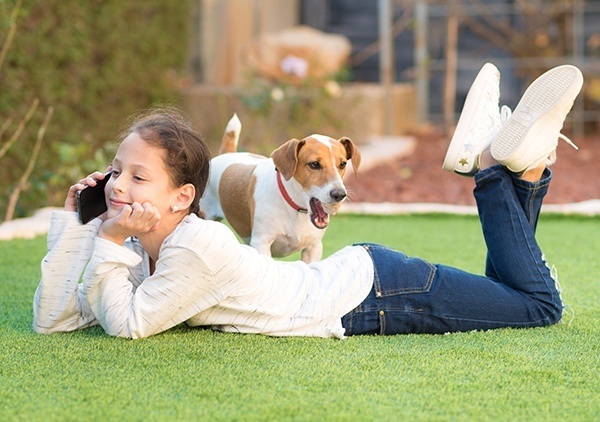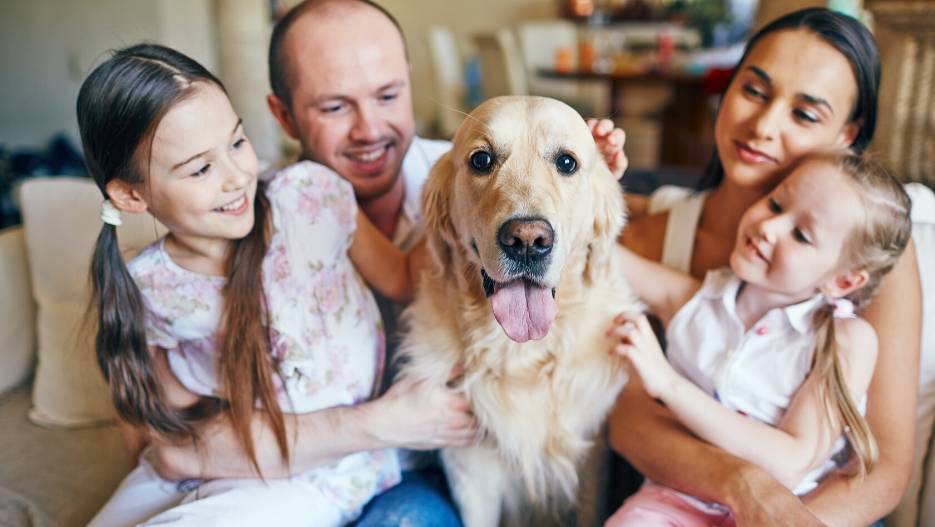If you’re on this page then we both agree that excessive barking is a serious problem for dog owners.
It’s normal for dogs to bark sometimes. It’s how they communicate. But when your dog is barking all the time it can lead to trouble with the neighbors (and even the law).
Problematic barking is also not normal dog behavior and usually signals an underlying issue that needs to be addressed.
Struggling to fix your dog’s barking issue? Keep reading for information and insight as to why dogs bark excessively, the different types of dog barks, tips to help you put an end to your dog’s incessant barking, and a few things you shouldn’t do.
Let’s get started!
Why do dogs bark?
Dogs communicate with us using different languages. One of these is body language, another is barking. Chances are you’ve heard different kinds of barks coming from your dog depending on the situation. Just like human speech, barking can express many emotions and serve many purposes.
6 Different types of dog barks

1. Greeting
One common reason your dog barks at you is because they’re greeting you!
When you come home after a long day of work or school and your dog barks as soon as they hear the door open. They’re bouncing around, their tail is wagging, and they’re excited that their playmate is back!
Your dog might also greet you in this way first thing in the morning. This is a happy, not scary bark that dogs do to say, “Hi!” to people they like.
2. Fear
Barking out of fear happens when a noise, person, or object startles your dog. This can happen anywhere, not just where you live!

Your dog may also bark at something they have a negative association with. If your dog was abused by a man before you adopted them, for example, they might bark fearfully when men come close.
3. Territorial
Territorial barking happens when a protective dog sees a potential threat/stranger approach their turf. By ‘turf’, I mean anything that your dog feels protective over. This could be their bed, family members, home, or yard, for example.
This barking typically gets louder as the trespasser gets closer. In these moments, your dog is on high alert and the barking may sound aggressive.
4. Attention seeking
Remember how barking is one of the main ways dogs communicate? This means that when they need something chances are they will bark at you.
Not getting enough attention? – Woof! Hungry? – Woof! Wants to go outside? – Woof!
If your dog always barks when they want something you may hear them bark a lot but have no idea why, which can be frustrating.
5. Separation anxiety
Some dogs don’t mind being left alone, but other dogs hate it. Barking can be a symptom of separation anxiety, along with things like pacing, being destructive, and urinating.
Hot Tip: Ever wonder what are some good dog toys to help with separation anxiety? We've put a guide together which explains which toys to buy and which to avoid.
6. Compulsive
Some dogs seem to bark because they enjoy hearing their own voice. You may know that all their needs are being met, they are not sick, and yet they will still bark constantly.
Excessive barking – Is it a serious problem?
Yes, excessive barking is a serious problem for a number of reasons.

It’s annoying, for one. When your dog is constantly barking and you don’t know how to handle it, you may get frustrated with your pet and not enjoy the relationship like you normally would.
If you’re getting annoyed there’s a good chance your neighbors are too (especially if you live in an urban area or apartment building with people close by). If your dog is barking late into the night or in the wee hours of the morning, your neighbors have every right to complain.
Noise ordinance laws help keep noise at a reasonable level depending on whether the area you’re in is residential, commercial, or industrial. For residential areas, there is usually a quiet time, “between 11 p.m. and 7 or 8 a.m. on weekdays and 11 p.m. or midnight until 8 to 10 a.m. on Sundays and holidays,” according to the L.A. Times.
The last reason that excessive barking is a serious problem is because happy dogs don’t bark much. Your dog barking constantly means that there is either a health problem, behavioral problem, or a basic need that isn’t being met.
Finding the root cause of the barking will help you determine a solution that lasts.
10 Great tips on how to stop excessive barking
1. Remove trigger
If you’re able to identify the reason for your dog’s barking and it’s something in their environment, the best way to deal with the problem is by removing the trigger.

Some dogs love looking outside and barking as passers-by. Sound familiar? Your dog is probably getting a reaction from those people which is reinforcing the behavior.
The simple solution is keeping curtains or blinds closed! Your dog can’t bark at what he/she can’t see.
2. Distract them
Maybe your dog barks excessively once in a while but it’s not a major problem. One way to stifle occasional over-barking is by distracting your dog in a way that makes it harder to bark.
For example, you might throw a ball for them to fetch with their mouth, so they won’t be able to bark anymore. You could also play tug-of-war, give them a drink of water, or command them to sit/lay down so they focus on your direction instead of whatever is making them bark.
3. Help Your Dog Communicate Without Barking
There are ways to train your dog to give you clear signals to tell you what they need without barking. You just need some patience and creativity.
For example, if your dog always barks when they want food and water you can train them to paw at a glass dish. When you hear the dish ‘clink’, you give them food or water but don’t react when they bark.
Another example is barking to go outside. You could instead hang a bell around the doorknob and when your dog rings the bell, you take them out. Your dog will quickly learn that these things work better than barking, and you’ll know exactly what it is your dog needs.
4. Teach Your Dog “Speak” and “Quiet” Commands
Training your dog to obey “speak” and “quiet” commands can be easy.
To train your dog to speak, wait until your dog barks. When they do, say, “Speak!” and then give them a treat. Do this a couple times and then when they’re quiet, use the command. Reward them for barking.
Once your dog has learned to speak, you can teach them “quiet”. When they’re barking, grab a treat in your closed hand (close enough so your dog can smell it). When they stop barking and are interested in your hand, hold your other index finger to your mouth and say, “Quiet!” Give them the treat.
Start this training in a calm and uninterrupted environment.
Once you dog has the hang of it, try it with a little distraction, like when you have a visitor. Next, try it in a different place like a park.
5. Desensitization training
When a dog is constantly barking at external stimuli outside of your control (like loud sounds, people walking by, bikers, or mailmen) and you know their trigger, desensitization training can help.
With this type of training, you don’t have to worry about keeping your curtains shut so your dog can’t see outside. You’ll also be able to handle your dog’s barking better when it occurs outside your home.
To train a dog by desensitization you start with the trigger far away. Let’s say your dog despises bicycles and barks every time he sees one. You might be at one side of a local park, and instruct a friend to go by on a bike far on the other side of the park where your dog can still see them.
If your dog sees the bike and doesn’t bark, give treats and praise. This way, they start to associate seeing bikes with treats/positive attention. Have the biker move a little closer each time. Eventually when the bike is close your dog may bark. Just ignore it and if they stop, reward them for being quiet.
6. Ignore, ignore, ignore!
If you’re trying to solve a barking problem it’s important that you never reward inappropriate barking by give it attention. When you react to your dog’s barking positively, either by petting and loving on them or encouraging them to continue, it reinforces the behavior.

The same goes for reacting to barking with negative attention or reinforcement. Yelling at your dog won’t make them stop barking; when they see you getting loud they think you’re joining in! Fear and physical punishments do not work, but instead damage the relationship between pet and owner.
So what CAN you do about barking that is annoying and always seems to happen at the worst time? If you’re positive your dog’s needs are being met (they don’t need to go out, not hungry, thirsty, or bored) and they shouldn’t be barking…
Ignore it.
Even if it takes a while, just walk away. Read a book, do some dishes, put your headphones in and listen to music. Just DON’T REACT to it. Eventually it will stop and your dog won’t have gained anything from barking that long. If this continues to happen they’ll realize it’s not worth it and stop.
You can’t ignore your dog’s barking for an hour and then lose it and yell at them to stop. If you do that they’ll think, “I just need to bark a whole lot and eventually I’ll get noticed.” It may be annoying at the time, but ignoring your dog when they bark will pay off.
7. Positively reinforce good behavior
This doesn’t mean you should stop giving your dog attention! When your dog is quietly playing with their toys while you cook supper, be sure to give them lots of love and praise!
Eventually your dog will realize when they bark you walk away or don’t pay attention. They don’t want that! When they notice that being quiet gives them the attention they crave, it will encourage them to bark less.
Training Note: Make sure that training sessions are a light, positive, and fun time for you and your dog.
Getting pressure from the neighborhood or police to fix your dog’s barking can be stressful, but putting that stress on your dog won’t help. Use a calm, firm voice during training and use positive reinforcement like treats and praise when your dog does well rather than punishing ‘bad behavior’.
One way to train your dog to bark less is to ignore them when they bark. When they have stopped, go and give them a treat and praise them. Once you’ve done this a few times, wait longer after they stop barking before rewarding them.
8. Make Sure Everyone is On the Same Page
Changing your dog from one that barks too much to one that only barks sometimes is hard work, and it’s imperative that you are consistent.
That might be easy if you live alone with your dog, but what about larger families?

It’s important that every family member is on the same page when it comes to what barking is allowed and what isn’t. Every person should know how to react when the dog is barking inappropriately. Involve everyone in training/strategy so they know how to prevent barking and encourage good behavior.
9. Keep Them Busy and Tire Them Out
Bored dogs tend to bark to voice their displeasure. When you’ve left and your dog doesn’t like being left alone, it’s like they’re barking in the hopes that you’ll hear them and come back.
For dogs like this, it’s important that they get proper exercise and play each day. This means at least a couple good walks if their health/energy levels allow it.
When it comes to dogs who have health problems or climates that don’t allow walking outside all the time, don’t worry. There are other ways to make sure your dog is stimulated and gets their energy out daily so they don’t bark as much.
If you’re away from home for most of the day, it’s a good idea to get a friend, family member, or pet-sitter to stop in once or twice a day. They can let your dog out so there aren’t accidents inside, make sure they have enough food and water, and give your dog some affection.
Food-stuffed toys like Kong toys with peanut butter are an excellent way to keep your dog busy for a while, as well as chewing toys, interactive toys, or chasing a favorite ball around.
10. Visit a Vet Behaviorist
Sometimes a dog barks a lot and you can’t pinpoint the reason no matter how hard you try. If this is the case it’s a good idea to visit a vet or vet behaviorist to rule out any physical or behavioral reasons for your dog’s barking.
Depending on the outcome of your vet visit your dog may require drug therapy or intervention to unlearn certain patterns and behaviors.
Some common medical reasons that cause dogs to bark include:
- Bee stings
- Brain disease
- Canine senility
- Vision or hearing impairment
- Pain
With regards to pain, keep in mind that dogs are incredible at hiding it when they’re hurt. Your dog may be suffering a lot but still wants to see you happy, so they’ll come to you with tail wagging and even act playful if they can muster it. Don’t assume because your dog looks okay that they’re not in pain.
This is why a vet is your best friend when it comes to making sure your dog is okay if they suddenly start barking a lot for no apparent reason. Your vet can also help you come up with an individualized action plan for dealing with the barking and monitoring progress.
Your vet may recommend one or more things depending on your dog’s needs. This could include anything from basic training and more mental stimulation throughout the day to behavioral therapy or calming chews for dogs who bark out of fear or anxiety.
Recommended Dog Training Courses
If you’re looking for good online dog training courses, in order to train your dog at home instead of going into a training facility check out our top two online video based training courses recommendations.
The Doggy Dan course is a behavioral training course using a mixture of ‘correction-style' training with aspects of positive, no-force methods, tackling problem behaviors like barking, phobias, separation anxiety, pulling on the leash, puppy training and hyperactivity - in ways that are innovative and effective.
The Brain Training for Dogs is a program by Adrienne Farricelli, a Karen Pryor Academy graduate. Her online training course revolves around force-free methods for canine brain development and behavior training. This is a great course for curious and bored dogs to help with anti-destructive behavior stemming from not being sufficiently stimulated.
Conclusion, and a of Couple Don’ts
Is barking causing serious problems for you and your furry friend?
If your dog has a problem with excessive barking, it’s important to deal with it sooner rather than later. The longer you’ve been allowing the behavior, the longer it will take to correct. If your dog has been barking inappropriately for years it may require more time and professional help, but you can still get to the root of the problem and see improvements.
Finding out what type of barking your dog is doing is one of the first steps to solving this issue. Are they barking because they are scared, territorial, sick, or just happy to see you? Once you know the reason behind the barking you can come up with an action plan to deal with it effectively and compassionately.
One thing that we don’t recommend is unsupervised, prolonged muzzling, because it can be dangerous for your dog and doesn’t treat the underlying issue. Another thing that we condemn is debarking, the inhumane and painful surgical practice of removing a dog’s laryngeal tissue to make their bark quieter. This surgery also ignores the underlying reasons for barking and is always risky for the dog.
Next Read: Help! My Dog Barks Non Stop While I'm at Work!








